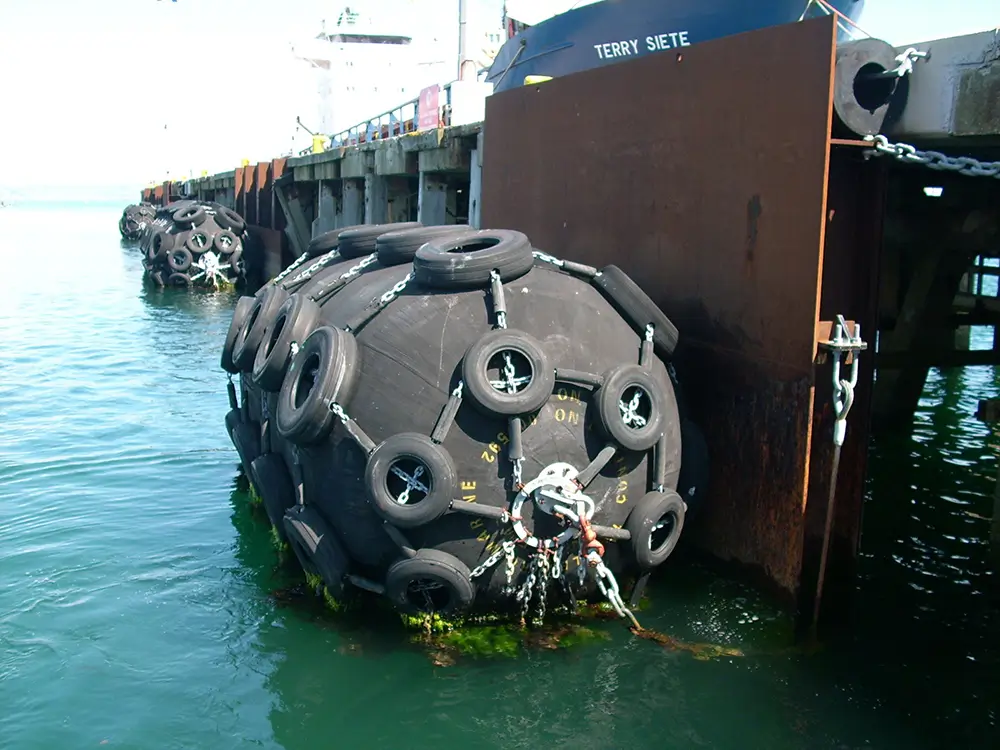Masa pakai fender sel
09/16/2025Why Do We Need Pneumatic Fenders?
When ships come into contact with docks, other vessels, or offshore platforms, the forces involved can be massive. Without proper protection, these impacts may damage both the ship and the port infrastructure. This is where fender pneumatik play an essential role. They provide a safe, reliable, and cost-effective solution to absorb energy and reduce reaction forces during berthing or ship-to-ship operations.

Memahami Fender Pneumatik
Pneumatic fenders, also called inflatable fenders, are marine fenders filled with compressed air. They are made of strong rubber layers that allow them to withstand repeated compression while maintaining performance. Because they rely on air pressure rather than solid materials, pneumatic fenders can deform significantly and return to their original shape, giving them excellent energy absorption and adaptability.
The Working Principle of Pneumatic Fenders
The principle is simple: when a ship makes contact, the fender compresses and the air inside is squeezed, dispersing the impact energy over a larger area. This reduces the reaction force on both the vessel and the structure. As a result, pneumatic fenders protect delicate hulls and lightweight piers that cannot handle high concentrated loads.
Key Advantages of Pneumatic Fenders
- Penyerapan energi yang tinggi – suitable for large ships and heavy impacts.
- Low reaction force – minimizes stress on the ship hull and dock structures.
- Excellent adaptability – works with vessels of different sizes, shapes, and freeboards.
- Easy handling – fenders can be deflated for transport and storage.
- Long service life – strong rubber construction with optional protective nets.
Typical Applications of Pneumatic Fender
This is where fender pneumatik truly show their value. They are widely used in a variety of marine operations:
1. Port Berthing
At busy ports, ships of different sizes need reliable protection when docking. Pneumatic fenders absorb high impact forces during berthing and allow ships to come alongside piers safely, even in rough sea conditions. Their flexibility also means the same fender can be used for multiple vessel types.
2. Ship-to-Ship (STS) Transfer
One of the most important applications of fender pneumatik is ship-to-ship operations. Whether it is crude oil transfer, LNG supply, or military refueling, these fenders create a safe cushioning zone between vessels. They prevent steel-to-steel contact and allow both ships to move slightly with the waves without damage.
3. Towing and Salvage Operations
During towing or emergency salvage, pneumatic fender act as mobile buffers. They can be positioned between ships, tugboats, or salvage vessels to avoid structural damage while handling heavy loads and dynamic movements.
4. Shipyards and Dry Docks
Pneumatic fenders are often used in shipyards for launching or docking new vessels. Because of their large deformation ability, they can absorb the energy of heavy ships sliding into the water, providing reliable protection for both the ship and the dock structure.
5. Offshore Platforms
When supply vessels approach offshore oil or gas platforms, safe contact is essential. Pneumatic rubber fender provide the necessary cushioning to protect both the vessel and the expensive offshore installation.
How to Select the Right Pneumatic Fender
Choosing the right fender size and pressure level is critical. The selection depends on:
- The size and displacement of the vessel
- Berthing speed and angle
- Water depth and tidal range
- Dock or platform strength
- Environmental conditions such as wind and waves
By considering these factors, operators can ensure the pneumatic fender will deliver maximum protection and cost efficiency.
Cost and Long-Term Value
While the initial investment may seem high, pneumatic fender provide long-term savings. They reduce the risk of expensive hull or dock repairs, lower downtime, and offer versatile use in multiple operations. Their durability and reusability make them one of the most cost-effective marine safety solutions available.
PERTANYAAN YANG SERING DIAJUKAN
Q1: What types of ships use pneumatic fenders?
They are suitable for all kinds of vessels, from bulk carriers and tankers to navy ships and offshore supply vessels.
Q2: Can one fender be used for different ships?
Yes. Because they adapt to different hull shapes and freeboards, the same fender can serve multiple ship types.
Q3: How often should pneumatic fenders be inspected?
A regular inspection every few months is recommended, especially before heavy-duty operations.
Q4: Are pneumatic fenders suitable for extreme weather?
Yes. High-quality pneumatic fenders are built to withstand waves, wind, and temperature variations.
Q5: Why choose pneumatic fender instead of solid rubber fenders?
They provide higher energy absorption and lower reaction force, making them more suitable for large vessels and flexible applications.
